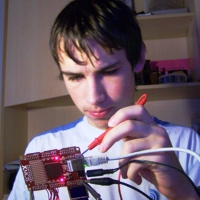WgXefMKkzTw
Join David May and Adam Marable as they discuss the potential use of XMOS processors as a means to build a cheap yet extendible parallel computing platform.
Adam has already taken the first steps towards this whilst undertaking a summer placement with XMOS in 2009.
As XMOS processors can be linked together via XLinks you could potentially make this into a modular platform by which you could add not just more memory as you upgrade, but more processors too!
Watch the video to see it in action and to learn more about what could be in store for the future using XMOS technology.
Developing a parallel computer for under $50
-
jason

- XCore Expert
- Posts: 577
- Joined: Tue Sep 08, 2009 5:15 pm
-
Folknology

- XCore Legend
- Posts: 1274
- Joined: Thu Dec 10, 2009 10:20 pm
Is this video referring to this project :
http://www.xmoslinkers.org/node/319
And if so, a couple of questions:
1) Where is the Sdram code, can't seem to find it there.
2) Is the Fat SD card code ok for distribution or could there be issues re licensing
regards
Al
http://www.xmoslinkers.org/node/319
And if so, a couple of questions:
1) Where is the Sdram code, can't seem to find it there.
2) Is the Fat SD card code ok for distribution or could there be issues re licensing
regards
Al
-
TonyD

- XCore Addict
- Posts: 234
- Joined: Thu Dec 10, 2009 11:11 pm
- Location: Newcastle, UK
Al, its does look and sound very much like the XShell project from Xmoslinkers.
I agree it is a shame that the SDRAM driver code is missing because the SDRAM is an important feature of this design.
I wonder if Xmos would consider releasing the PCB artwork and gerbers under a public license (Creative Commons Attribution-Share Alike 3.0 ?) so others could build the board. As David May said in the video it would make a interesting contribution towards the $10 computer for the developing world.
Add a Virtual Machine as discussed elsewhere in this forum and you have a very, very interesting project.
-
Berni

- Respected Member
- Posts: 363
- Joined: Thu Dec 10, 2009 10:17 pm
Well you can get FAT16 code and RAM code on the xlinkers website. I actually used the FAT16 code. Its not the best file system in the world but it works.
Anyway i like the idea of a xmos computer. Might end up being something quite useful.Nice thing is that you could execute programs off the SD card using a bootloader.
Anyway i like the idea of a xmos computer. Might end up being something quite useful.Nice thing is that you could execute programs off the SD card using a bootloader.
-
shawn

- XCore Addict
- Posts: 238
- Joined: Thu Dec 17, 2009 5:15 am
BASIC hmmm...
I owned an IBM system23, an 8086, It was all BASIC.
Aimed at small enterprise and most likely there main
development platform for the the PC/AT, PC/XT...
Fully implemented BASIC provided enough raw IP to
poll the savy business programers towards there new PC.
Nice work, Adam...
I owned an IBM system23, an 8086, It was all BASIC.
Aimed at small enterprise and most likely there main
development platform for the the PC/AT, PC/XT...
Fully implemented BASIC provided enough raw IP to
poll the savy business programers towards there new PC.
Nice work, Adam...
-
nieuwhzn

- Member++
- Posts: 26
- Joined: Sat Dec 12, 2009 6:45 am
A very interesting exercise and great that Adam was able to get this done so quickly. It shows that the XMOS approach is very powerful.
However, I think that this application is already pushing the single core chip to its limit since there are only 8 threads available. What would be really interesting is to have a real parallel system where not only different hardware task are performed by different XMOS chips but also the different software tasks that need to be performed within a complex multitasking OS. The communications between the different chips would go over XLinks.
The current OS's are basically monoliths. The challenge is to have an parallel OS which dynamically identifies the hardware that is available to it and distributes itself over the different cores. Just dreaming.....
However, I think that this application is already pushing the single core chip to its limit since there are only 8 threads available. What would be really interesting is to have a real parallel system where not only different hardware task are performed by different XMOS chips but also the different software tasks that need to be performed within a complex multitasking OS. The communications between the different chips would go over XLinks.
The current OS's are basically monoliths. The challenge is to have an parallel OS which dynamically identifies the hardware that is available to it and distributes itself over the different cores. Just dreaming.....
-
BrianMiller

- Active Member
- Posts: 33
- Joined: Wed Jan 13, 2010 7:50 am
- Location: USA, NC, Raleigh
I hate to say it, but Adam hasn't done anything that hasn't already been done to death for 20 years on a mountain on processors.nieuwhzn wrote:A very interesting exercise and great that Adam was able to get this done so quickly. It shows that the XMOS approach is very powerful.
However, I think that this application is already pushing the single core chip to its limit since there are only 8 threads available. What would be really interesting is to have a real parallel system where not only different hardware task are performed by different XMOS chips but also the different software tasks that need to be performed within a complex multitasking OS. The communications between the different chips would go over XLinks.
The current OS's are basically monoliths. The challenge is to have an parallel OS which dynamically identifies the hardware that is available to it and distributes itself over the different cores. Just dreaming.....
-
Heater
- Respected Member
- Posts: 296
- Joined: Thu Dec 10, 2009 10:33 pm
BrianMiller "I hate to say it, but Adam hasn't done anything that hasn't already been done to death for 20 years on a mountain on processors."
That's not exactly true and somewhat missing the point. Whilst the end result may look like anything from a C64 onwards the means of achieving it are worlds apart.
In the past if you wanted a serial port you needed a UART chip.
For video a video chip was required.
Then something to handle a keybaoard, a PIO chip say.
And so on and so on. For every peripheral function another chip to implement it was required.
So now we have the XMOS "Software Defined Silicon" where a chip with enough speed and, importantly timing determinism, can be used to implement those peripherals in code with great flexibility.
The board under discussion is just a demo of that capability.
That's not exactly true and somewhat missing the point. Whilst the end result may look like anything from a C64 onwards the means of achieving it are worlds apart.
In the past if you wanted a serial port you needed a UART chip.
For video a video chip was required.
Then something to handle a keybaoard, a PIO chip say.
And so on and so on. For every peripheral function another chip to implement it was required.
So now we have the XMOS "Software Defined Silicon" where a chip with enough speed and, importantly timing determinism, can be used to implement those peripherals in code with great flexibility.
The board under discussion is just a demo of that capability.
-
BrianMiller

- Active Member
- Posts: 33
- Joined: Wed Jan 13, 2010 7:50 am
- Location: USA, NC, Raleigh
I've seen a few projects that use cheap micro controllers to generate video and interface to IO with a minimum of components. Those games in a joystick that hook up to the tv products come to mind. It's a software development *nightmare*.Heater wrote:BrianMiller "I hate to say it, but Adam hasn't done anything that hasn't already been done to death for 20 years on a mountain on processors."
That's not exactly true and somewhat missing the point. Whilst the end result may look like anything from a C64 onwards the means of achieving it are worlds apart.
In the past if you wanted a serial port you needed a UART chip.
For video a video chip was required.
Then something to handle a keybaoard, a PIO chip say.
And so on and so on. For every peripheral function another chip to implement it was required.
So now we have the XMOS "Software Defined Silicon" where a chip with enough speed and, importantly timing determinism, can be used to implement those peripherals in code with great flexibility.
The board under discussion is just a demo of that capability.
The advantage of using XMOS processors is simpler software design and reduced complexity in most cases. I like it.
-
otitov

- XCore Addict
- Posts: 207
- Joined: Thu Dec 10, 2009 11:00 pm
- Location: Mexico
please, show me International Karate + running on this computer :-)Heater wrote:...Whilst the end result may look like anything from a C64 onwards the means of achieving it are worlds apart...
